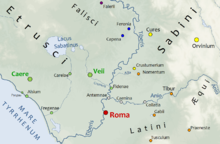Sabine
The Sabines ( Latin Sabini ) were a people descending from the Umbrians in the Sabine mountains of the Apennines . The people were part of the Indo-European Sabeller in central Italy .
They were immediate neighbors of the Romans . At the beginning of the 5th century BC They represented one of the main dangers for Rome because they ruled the Via Salaria and could threaten Rome directly. They received 268 BC Chr. The Roman citizenship after 290 v. Were finally fallen under the rule of the Romans .
According to the ancient Roman legend, the Sabines were the original inhabitants of the Quirinal (one of the seven hills of Rome ) and were founded around 750 BC. BC, initially united with the populus Romanus under a dual kingship of their king Titus Tatius and the Roman king Romulus . The Sabines are known, among other things, from the legend of Titus Livius about the robbery of the Sabine women , in which it is reported how the women and daughters of the Sabines were robbed shortly after the city of Rome was founded because there were too few women in Rome.
The most important centers of the Sabine Empire were Cures and Reate , other important cities including Amiternum , Nomentum , Nursia , Orvinium and Eretum .
The Roman cognomen Sabinus is derived from the tribal name Sabiner and the first name Sabine is derived from its female form Sabina .
Famous Sabines were Numa Pompilius , Titus Tatius , Ancus Marcius and Attius Clausus .
literature
- Robert M. Ogilvie : Early Rome and the Etruscans. Translated by Irmgard Götz. Deutscher Taschenbuch Verlag, Munich 1983, ISBN 3-423-04403-9 .
- Massimo Pallottino : Italy before Roman times . Translated from the Italian by Stephan Steingräber . CH Beck, Munich 1987, ISBN 3-406-32012-0 .
- Gary D. Farney, Giulia Masci: The Sabines. In: Gary D. Farney, Guy Bradley (Eds.): The Peoples of Ancient Italy. De Gruyter, Boston / Berlin 2017, ISBN 978-1-61451-520-3 , pp. 543-557.
Web links
Individual evidence
- ↑ On the language of the Sabines see Giacomo Devoto: History of the language of Rome . Translated from the Italian by Ilona Opelt. Carl Winter Universitätsverlag, Heidelberg 1968, pp. 78–86.
- ^ Massimo Pallottino : Italy before Roman times . CH Beck, Munich 1987, ISBN 3-406-32012-0 , pp. 109-115.
- ↑ Robert M. Ogilvie : The early Rome and the Etruscans. Deutscher Taschenbuch Verlag, Munich 1983, ISBN 3-423-04403-9 , p. 118.

